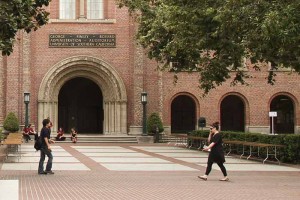USC offers a variety of cultural outlets
Located in the heart of South Los Angeles is USC’s expansive, private-yet-integrated campus, a beloved, didactic home to almost 40,000 students. USC, a school that stands as a miniature facsimile of the vast metropolis that surrounds it, also stands as one of the fountainheads of international education.

Main stage · Bovard Auditorium, home of USC’s Visions and Voices program, will offer a plethora of multicultural performances and presentations throughout the Fall semester — many of which are free with student ID. - Carlo Acenas | Daily Trojan
Filled with various ethnic groups, cultures and languages, Los Angeles is a bustling hub of multiculturalism that never fails to offer its residents a generous smorgasbord of multicultural satisfaction.
Much like Los Angeles, USC is a cultural mosaic, as it, too, is a more condensed haven for international immigrants and their respective cultures. Around campus, it is not difficult to notice and feel the multiculturalism that pervades USC’s dining halls, food courts, dorms, classrooms and curriculum, media-outlets, faculty and alumni that are all present on campus any given day.
What makes USC’s cultural mosaic possible is the university’s ability to support international cultures — that is, cultures that exist between two or more nations. At USC, it is the allure, exoticism and mystique of certain cultures (Thai, Indian, Korean, Japanese, Chinese, Mexican, etc.) that allow them to coexist, rather than assimilate to the sometimes-overwhelming sense of American patriotism that is also easily noticeable on campus.
USC’s renowned multiculturalism effected international and cultural diversity over past decades, and this year specifically. USC’s freshman class is making its university debut as the most internationally diverse class in the history of the Trojan tradition.
A strong multicultural presence on a campus like as USC creates a vast number of niches that can be explored in various arenas, including extracurricular clubs and fraternities, some of which focus on particular cultures or demographics, such as the Multi/Interracial College Students and Sigma Lambda Beta International Fraternity, Inc. International food courts on and off campus are examples of international gastronomy making itself known at USC. And in the classroom, not only will students meet and interact with fellow pupils from other countries and cultures, but students will also have the chance to enroll in international or cultural-oriented classes. These are just a few of the ways USC has been serving students as a pioneering multicultural university for many years.
Some aspects of USC’s diverse student population are hard to ignore. This can either make it easy for new students to find their place at USC, as there are a near-infinite number of cultural gems, outlets and activities to discover and get involved with, or, such an immense diversity can make students feel even more lost, in an ever-growing sea of concentrated cultures that can be sensory overload. After all, USC is a lot to take in, especially if you are unfamiliar with Los Angeles.
With cultural stimuli bombarding the student body’s senses, it is imperative to recognize and to take advantage of the most influential aspects of culture at USC and the platforms through which culture makes itself readily available to students. This upcoming semester new and returning students can look forward to an influx of exceptional international artists, concerts, video games, restaurants, classes and productions at USC.
For the fall semester, and throughout the year, Visions and Voices will put on a number of exciting international-themed presentations, such as Pika Pika. There will be myriad foreign films released, many of which will be screened at USC’s School of Cinematic Arts (typically free with reservation and student ID). And although the University Village, across the street on Jefferson Boulevard, will start renovating circa 2013 (as part of USC’s strategic plan), there is still ample time to indulge in the international food courts, some new and some old, that serve traditional, foreign cuisine.
Culture is what makes USC what it is, a snapshot of Los Angeles or Los Angeles’ salad-bowl-type concoction of heterogeneous ingredients in the form of multiculturalism; our school is a diverse community of brilliant individuals coming to learn, grow and achieve — the gateway to the real world, be it for a student from Sri Lanka or a student from Pasadena.
